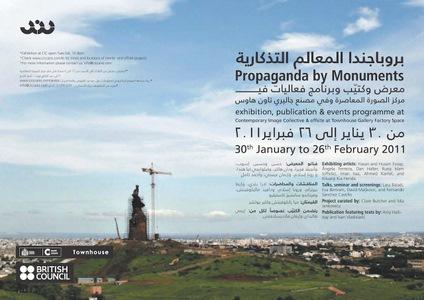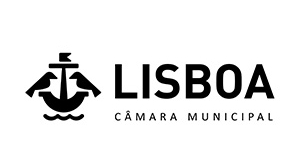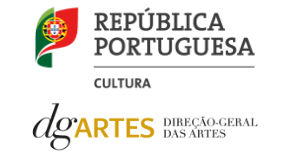Clare Butcher's Cairo Dairy: Exhibitions by Increments
(Some musings from a curator accidently caught in the revolution)
DATE: JANUARY 23, 2011 11:28:37 AM GMT+01:00
Correspondence
To: Clare Butcher
‘By the way, to add to our troubles, 25th January is a (highly unpopular) national holiday: National Police Day” (ha!). CIC will be business as usual and so will the airport. It was invented last year as a celebration of some great victory the police had over the Brits in the past, the problem now being the police’s tendency to murder Egyptians in the present, so people are taking it as a day of protest rather than celebration. By the time you land the roads will surely be totally clear but I’ll text you updates. They tend to organize roadblock checkpoints at this time of night, but they are normal and the driver will be used to navigating around them so don’t be alarmed…’
This is a beginning. I’m carrying large rolls of photographs and carefully packed images and DVDs: objects all part of an exhibition we’ve been trying to pull off in Cairo since last year. The exhibition came as the result of an invitation from Mia Jankowicz at the Contemporary Image Collective – a primarily photographic space for exhibitions and workshops in downtown Cairo. Mia had been approached to do a show of photography and other media which might include the work of South African artists and so she asked me to do some brainstorming about some possible themes – neither of us wishing to make anything that would amount to a geographic survey show. And so ‘Propaganda by Monuments’ as a concept was born.

Taking its cue from the short story by Ivan Vladislavic written during South Africa’s tumultuous turn of apartheid to democracy the story offers a fictional correspondence between an opportunistic South African businessman and a translator working for a department of the former Soviet Union. The businessman is looking for a partner in the export/import scheme of the century – a monumental transport of removed Lenin statues to South Africa for re-fashioning as the country’s new heroes (a bit smaller to allow for eyes and ears of course!) Satirical humour aside, the story has become something of a pedestal for me – supporting or rather framing the work of so many contemporary artists working and thinking about their immediate conditions in a post-something context (be it -colonial, -communist, -agrarian, -secular, -political, -modern).
Spurred by the unveiling of a number of monuments around the continent – constructed by and therefore reflecting Africa’s commitment to a new deal with East Asia – we identified an interesting cross-section of both geographically and content related work by Hasan & Husain Essop (ZA), Angela Ferreira (ZA/PO), Dan Halter (ZM), Runa Islam (UK), Iman Issa (EG), Kiluanji Kia Henda (AO), Ahmed Kamel (EG), as well as a number of related projects which we aimed to show in part of a parallel programme of screenings and discussions (such as work by Lara Baladi, David Maljkovic, Eva Bertrum and Fernando Sanchez Castillo).
So here I am, six months later, playing personal courier, as anything going through Egyptian customs by post might be held up, never released, or at least damaged in the unpacking. I fight air attendants tooth and nail to get these ‘oddly sized’ pieces of luggage on board with me from Cape Town through Johannesburg, to Paris, to Amsterdam (where I stop to collect acid-free archival tape which I am told is not readily accessible in Cairo) and then to the place where By the time I land, the roads will be clear…
DATE: JANUARY 25, 2011 11:28:37 AM GMT+01:00
The roads are clear. Very quiet in fact. Particularly by Cairo standards. Though it is 3am when I finally meet Mia, there are still roadworks in action, maintaining roads that cut through centuries-old neighbourhoods. The introduction of these roads opened up certain sections of the city completely – laying bare some architectural gems which had been hidden, wedged between one gem, and another and another. I watch the glowing lights of mosques, palaces, lavish gardens, bus stations, McDonalds, not believing that I am in the Cairo. The driver weaves his way onto the major downtown thoroughfare Al Kasr Al Aini. Mia’s apartment is just off this road and behind the former site of the Contemporary Image Collective, which, just after Mia’s taking on artistic directorship, moved further into the heart of the central downtown area, a stone’s throw from Tahrir Square.
It is here where today, Mia explains, as promised, thousands did in fact gather to protest the under-delivery of many basic civic needs and brutal police enforcement of the 30-year emergency law under Hosni Mubarak’s rule. The network of streets splicing the city as well as the construction of squares such as Tahrir, have all been part of a kind of latter day Haussmannisation process – ensuring the heightened visibility of citizens. Like the architectural gems, they are no longer hidden, no longer wedged between alleyways and well-worn desire lines. In this city, of 18 million people – bigger than Istanbul – citizens are watched. And watch themselves and each other.
Iman Issa – one of the artists in the exhibition we are about to install – wrote in an article, Paranoid City: ‘Cairo is a city that invites paranoia in its inhabitants. The city is divided between a central system highly believed to benefit those who are responsible for its maintenance, and a set of individual practices that compensate for the failures and lack of this central system. These individual practices manifest themselves not only in the numerous informal housing blocks that punctuate the urban landscape, but seep into every aspect of the city’s life and activity, from parking cars to signing contracts. These practices are as fluid as they are a constant attempt to deal with an unstable system that they themselves continually change’.
DATE: JANUARY 26, 2011 11:28:37 AM GMT+01:00
Things are as expected today. The level of traffic is very much Cairo and a drive to the CIC which should be a 20 minute walk takes also 20 minutes by car in amongst copious hoots, and the sounds of a hundred radios blaring all genres of music ranging from the regional religious to the ‘Arab World Pop’ I know so little of. It’s not too hot today. The same can be said for the situation. Apparently the police presence round the major squares is ‘normal’ and as I am learning about Cairo’s timetable, if there are going to be any demonstrations, they will only get going after midday prayers. There has been some activity on the street today.
We meet Mohamed Abdallah and Mona Makram, the other members of the CIC team directly involved with the exhibition. Mohammed has been a translating genius: obsessing and finishing the first Arabic translation of Vladislavic’s short story. Ivan has kindly allowed us to use the title, translate the story and present it in the exhibition publication. Mohammed, in his feverish way, excitedly relayed the subtle difficulties of translating a story about translation – or rather what goes missing in it between the businessman and the Soviet Gregov.
We look through the space, the rolls go to the framer, and we start making title cards before heading to the off-site location for Runa Islam’s Scale 1/16 inch = 1 foot work. The Townhouse Gallery is an established component of Egypt’s independent artistic landscape. Their Factory Space is constantly housing a host of projects from photographic awards to large-scale installations. This is what they’ve offered for Runa’s work. We meet Mido there, the former quality control engineer-turned technician who’ll be working on the project. I deliver the black box resembling a bomb, which is, in fact, a sychroniser made by a techie at the Rijksacademie in Amsterdam. Thus completing the little package’s journey from friends in Slovakia, to Amsterdam, to Cairo and now into Mido’s hands. He’s bristling with excitement to try it out, not that such a simple device could keep two DVD players looping endlessly in perfect time with each other.
As if Mido’s bristling enthusiasm were contagious, people are bristling on the street, but with some other energy. We go inside. We hear a collective voice rise up from the blocks below as people venture out in a kind of loose formation once more. The demonstrators continue. Still they are peaceful. Simply walking and chanting ‘Peaceful, peaceful’. The police seem to be willing to put up with this much. They watch from their corners in vans, truncheons resting, dynamically, on shoulders, on boots. Driving back to the apartment by taxi we once again pass Tahrir Square, where police have taken the place. They are young. I get a close-up of some policemen when the taxi driver rolls down his window to say something to them. The exchange is a strange one. Mohammed reminds us that these boys are people’s sons. It’s a viable employment option. Though a diabolical one.
Despite warnings about travel through the city, that evening we head over the river, across the 6 October Bridge. And into another world. A much wealthier neighbourhood. Boutiques and warm lights line the streets. It is quiet. We’re here to see Lara Baladi, an Egyptian-Lebanese artist, who made a work for the last Cairo Biennial – Borg el Amal (2008) (Tower of Hope). The work, a tower of traditionally fired bricks and reinforced steel containing a sound installation, was first erected as an uncomfortable appendage of the Cairo Opera. Through its site and situation Borg el Amal claimed another kind of cultural aesthetic - as an agrarian and informal icon of contemporary, peripheral Cairo in stark contrast with state-controlled urban development. We were at Lara’s apartment to plan the seminar attached to our exhibition, together with the American University of Cairo’s Bruce Ferguson (whom we know from Thinking About Exhibitions [1996]) and a colleague in Islamic Law, Amr Sharlakany. We hope that through the seminar we could address the work’s monumentality through a number of lenses: urban geography, city branding, anthropology and visual studies. And we have a productive discussion with them. Amr was down at the protests all day. He’s exhilarated. I decide that I’ll make lemon meringue pie for the event which will happen on Monday, following the exhibition opening on Sunday evening.
DATE: JANUARY 27, 2011 11:28:37 AM GMT+01:00
Thursday everyone knows will be the day that everyone waits. Some are waiting for Friday. And whatever the Muslim Brotherhood will urge followers to do after midday prayers. The wires online, social networks, are hot with information. Cellphone reception downtown is still dodgy. But nothing to worry about really. We are waiting for work to be let through customs and work to come back from the framer, Raffy, and posters to come from the printer, and and…things are not running as usual, though we try and pretend. We get a phone call: the printer was arrested last night. There’ll be no posters, no curatorial texts, and suddenly we hesitate pressing the ‘send’ button on the e-flyer announcement.
What are we doing here? What would you do? Is it even ethical to have an opening at such a time? What if things get worse (or better…depending on how you see it)? Or do people need something to focus on that is but isn’t directly related to the ‘real’ of here and now? And yet it is so related. We’re talking about revolutions, shifting paradigms, changing value systems and the individual’s place, possibility for action and perspective regarding all this. But perhaps the cases we’ve chosen are for when the dust settles, as it were; when history has materialised and can be put in front of you, at least a version of it, and discussed, pulled apart, pulled down, shipped across the world. Maybe this is premature.
DATE: JANUARY 28, 2011 11:28:37 AM GMT+01:00
Internet is down. And just as we hear this… cellphone reception is cut off. We make the fairly desperate decision to go downtown to the gallery – I need to feel that I am doing something. The streets are almost deserted. It’s safe to go in and out before prayers begin and, at some point, we make the decision just to stay even after prayers – as if we’d collectively but silently agreed because we want to see for ourselves what happens.
Mohammed spends some time translating, for our benefit, the ‘How to protest intelligently: important facts and tactics’ guide being distributed via email and photocopy before all these communication lines ceased. We are amused by the seeming naivety of some of the imperatives – ‘Head towards important government buildings while shouting positive slogans – in order to take them over!’ and ‘Hold your ground, Egyptian!’ So straightforward. So practical. Including everything from carrying lemons to suck on to stop choking when tear gassed to holding a rose in remembrance of the last Police Day.
I’m cutting labels for the works as the sound of holy sermons transition into righteous anger. The humming down below is that of people coming out of mosques, and beginning to gather. This is shortly followed by the tear gas canons beginning to fire. Amidst shouts of Allahu Akbar (Allah is the greatest), this is clearly not only a fight for Islam, as women, children, orthodox Muslim men, teenagers, KFC employees, all walk those wide Haussmanesque streets meant to prevent revolutions from getting out of control. But they do control each other, by an amazing sort of group editing process: each one looks out for the other, making sure that emotions do not run away with people, that the stone throwing never results in direct confrontation. Well, this is as long as the plain-clothed government-paid mercenaries don’t get to them first. We witness from the balcony where we stand a number of protesters being pulled out of neighbouring apartments, being beaten by these men and taken away to riot vans around the corner. We make sure to leave the doors open for getting out, or to let others in, or whatever.
The question, or even the possibility, of an exhibition – is the furthest from our minds at this point. Where is the place of art in a revolution? Does it start them? Does it finish them? Can it only dissect them?
The demonstrators are coming closer, as are the police barricades. At one point, we stand above a sea of hundreds sitting on the tarmac, daring the police to fire more tear gas and intimidation. There’s a gas station between the two groups, forming some kind of invisible explosive border. Suddenly the protesters move back and we see that another group of police are hemming them in from a side street. The police line in front announce to anyone remaining in the apartments around - i.e. us - that we have 5 minutes to get out of the area. We grab the closest things and leave, realising once we reach the street that we don’t really have a plan. So we walk.
Walk the back streets, the old ones, which lead in and through and around the ‘modern’ paranoid trajectories cutting across the city. We are sheltered within the parts of the downtown that remain hidden, where life could almost be normal. An upholsterer continues his work in the garage next to his house. And men sit at tables speaking to passing protesters, asking them the safest route. Mohammed’s with two European women, which poses a risk to him. Though in fact, we also manage to get through a number of barricades by virtue of unearned British passports – innocently ‘foreign’. We don’t go back to Mia’s. The situation is thick and gaseous around the Al Kasr Al Aini. Instead we wait in a neighbouring apartment and listen to a fuzzy reception of the BBC world. Three beeps before news on the hour: beep beep beep. We also hear from a nearby local radio that a curfew has been imposed.
A long night of radio static. Some protesters come in the early morning to relate their stories of the situation ‘down there’ in the square. They are elated. So hopeful despite the ambiguous arrival of the military last night and the burning of Mubarak’s headquarters. ‘People were forming human chains around the national museum!’ they say, to prevent looters: ‘There are certain elements of our culture that they cannot destroy’.
DATE: FEBRUARY 11, 2011 11:28:37 AM GMT+01:00
Two weeks. Only two weeks later, and I am watching the television screen show footage of thousands upon thousands celebrating in the streets after Mubarak made the sudden turnaround from his bitterly disappointing address yesterday. He’s stepping down and Egypt – all its frustration, and peaceful stubbornness – is released into a sea of good will. This is a revolution that worked. Or has it? So many questions for tomorrow linger. For the day after. When the dust settles. And we have old monuments that need to go somewhere else, new ones which must find leftover pedestals, and the shifting sands underneath the paving stones of Liberation Squares.
* Endnote:
The exhibition ‘Propaganda by Monuments’ is due for postponed realisation at the CIC, Cairo in the coming months. Due to the auspicious nature of the events around the exhibition’s development, the curators are deeply aware of a necessary inclusion of this significant political moment within the project’s conceptual framework. Please keep updated on the CIC website and Artthrob listings of the new exhibition, discussion and publication launch dates. http://ciccairo.com/ie
in Artthrob

